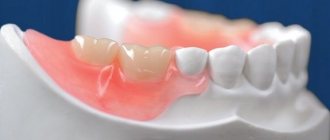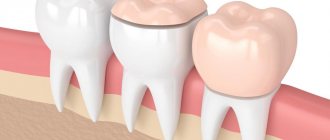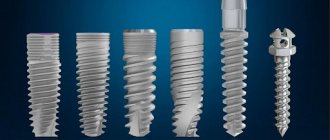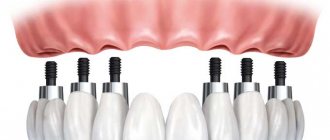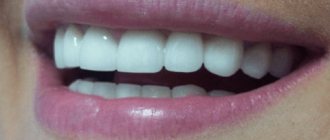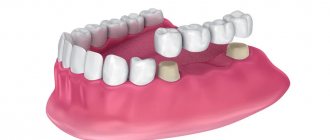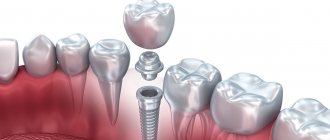A bridge on implants is a reasonable option for prosthetics in case of loss from 3 teeth to their complete absence. Cheaper than implantation of each lost tooth, more reliable than bridge prosthetics on your own teeth.
In our Center they are installed after computer diagnostics and bite examination, and are manufactured in our own dental laboratory. A lifetime warranty is provided for implants in our Center, and 25 years for metal-free crowns as part of a bridge.
A dental bridge on implants is a non-removable orthopedic structure made from welded crowns to restore several teeth in a row.
- Difference from traditional bridges The bridge is supported not by your own teeth, but by pre-installed implants. There is no need to grind down the enamel of adjacent healthy teeth.
- Difference from classical implantation Each tooth does not require a separate implant; fewer are installed. And the bridge includes crowns for each tooth. Allows you to save money.
Bridge prosthesis on implants
Advantages
If you lose several teeth in a row, dental bridges on implants are the right solution. Allows you to correctly distribute the load and not use healthy teeth.
- Neighboring teeth do not deteriorate. The supports are implants implanted into the jaw, and not your own teeth, which must be ground down.
- Durability Implants last a lifetime, and the service life of the prosthesis is at least twice as long as that of classic bridges.
- Aesthetics Crowns are no different from your own teeth. The aesthetic gingival contour is recreated.
- Affordability Savings compared to classic implantation, when each tooth is replaced with an implant and a crown.
What are dental implants
Implant-supported prosthetics differs from classical prosthetic technology. The method is based on the rehabilitation of the dentition without the involvement of healthy units. Instead of a missing or non-viable tooth, a separate implant is implanted - a titanium root that imitates a natural one, onto which an orthopedic structure (crown, bridge, complete denture) is fixed. With the help of dental implants, any number of units can be restored - from 1 to all in a row.
Is it always possible to put a bridge on implants?
A bridge prosthesis on implants is suitable in any clinical situation, regardless of the extent and location of the defect in the jaw
Installed when:
- loss of three adjacent teeth in a row; with fewer teeth there is no need
- absence of outer teeth in a row , when there is no support on one side for a conventional bridge
- complete edentia , when there are absolutely no supports for fixation for a traditional bridge
Bridges on implants do not require grinding of adjacent teeth.
They are used even in cases of terminal defects and complete edentia, which cannot be achieved with traditional bridge prosthetics. Another undoubted advantage is that there is no need to prepare the enamel of neighboring teeth, which means they will remain healthy and last longer.
Levin Dmitry Valerievich Chief physician and founder of the Doctor Levin center
Structure care
Care for a bridge on implants is the same as for living teeth. Regular cleaning is required - twice a day. In addition to a regular toothbrush, it is recommended to use special brushes to remove food debris from under the denture, floss and irrigator. It is advisable to start cleaning from the inside of the teeth and finish from the outside. After eating you need to rinse your mouth. Every six months you should visit the dentist for a preventive examination.
If you are missing one tooth or several, and even if there is not a single tooth left in your mouth, come to Uni Dent dentistry. Our specialists will “build” a high-quality bridge between the remaining molars, which will allow you to restore a “complete set of teeth” and acquire a confident smile, and, therefore, get rid of psychological discomfort. In addition, you will be able to chew any food efficiently, enjoying its taste.
How many implants are needed for partially missing teeth?
When calculating the number of implants, we take into account the distribution of chewing load
The load on the jaw when chewing should be uniform so that there is no subsidence of the gums and bone tissue under the hinged crowns. This will ensure the durability of the prosthesis and maintain aesthetics. Therefore, fixing a bridge on 2 implants is not always the right solution. It is recommended to use a 1:2 calculation - one implant for 2 crowns . Accordingly, the more teeth are missing, the more implants will be needed.
1-2 teeth missing
In this situation, bridges supported by implants are not relevant; teeth are restored separately. Each one has its own implant, which is covered with a separate crown. In this case, it is not recommended to combine crowns - if one is damaged, you will have to remove two at once. No 3 teeth
The most common clinical picture.
If there are no three adjacent teeth in a row, 2 implants are implanted along the edges of the defect, and a prosthesis for 3 teeth in the form of interconnected crowns is fixed on them. The outer ones are mounted on supports, and the middle one is hinged. You can install three implants, but this solution is cheaper. 4 missing teeth
When installing a bridge on 4 missing teeth in a row, the number of supports increases to three, and the number of crowns increases to four.
If you use two supports, then there will also be two mounted crowns. Atrophy of the jaw bone under the prosthesis cannot be ruled out due to uneven load. And the risk of prosthesis breakage increases due to increased pressure on the central part. No 5 teeth
Bridge prosthetics on implants is possible for 5 teeth or more. If five teeth are missing, three implants are needed. If a bridge of 6 teeth or more is required, three supports are used - the number is calculated by the number of crowns in the structure. The degree of future load and its distribution on the bone tissue are taken into account to prevent atrophy.
A little about bridges
Popularly, bridges are called the short word “bridge”. They received this name in dentistry due to the peculiarities of fixation. This type of dentures is represented by crowns, which are held on adjacent “supporting” teeth and replace the functions of their missing “brothers”. Thanks to the paired supporting fastening system, such a prosthesis is called a bridge.
A bridge is a one-piece structure that replaces one or two missing teeth in a row and is installed on the supporting teeth.
Modern bridge-like devices have a frame made of medical or precious alloys, which are coated with a ceramic composition. Various metal-free materials, metal-ceramics, zirconium dioxide or dental plastics can also be used.
You should be wary of your dentist's proposal to install a bridge if you have a large number of missing teeth. This can overload the jaws, involve too many supporting teeth and lead to the fragility of these structures.
Full bridges for the lower and upper jaw
In case of complete edentia, fixed bridge structures are reinforced with a metal arch
The arch unites the crowns, increases the strength of the bridge and allows it to withstand severe chewing loads. The number of implants is determined depending on the clinical picture, anatomical features and jaw size.
- In the upper jaw, bone tissue has a lower density, therefore, during implantation, a larger number of implants are used - 8 pieces.
- On the bottom , on the contrary, the bone is denser, so 6 implants are enough for complete prosthetics. This is subject to standard jaw sizes. If the patient has a large jaw, two more implants are added to evenly distribute the load and ensure safe operation of the prosthesis.
A dental bridge with 6 implants is usually solid, but a denture with 8 implants can be made segmented - from four sections. This is a more convenient option - if necessary, you can remove only one segment, and not the entire prosthesis.
Also, in case of complete absence of teeth, the All-on-4 and All-on-6 protocols are used. 4 or 6 implants are installed on one jaw in a certain way, observing the principles of load distribution. Immediately on the day of implantation, a temporary non-removable adaptive prosthesis is installed, and after 6 months it is replaced with a permanent one.
Indications and restrictions
| Indications | Contraindications to implantation |
| End defects | Mental illness |
| Unsatisfactory condition of the outer teeth | Somatic pathologies in the decompensated stage |
| Segmental row defects | Endocrine disorders, oncopathologies |
| Multiple edentia (absence of more than half of the units) | Acute infectious diseases |
| Complete absence of teeth | Acute inflammatory processes in the oral cavity |
What materials are they made of?
Dentures are manufactured in the Center’s own dental laboratory, you can choose the appropriate option to suit your taste and budget
- Metal-ceramic The base of the crowns is a metal alloy, the top is covered with ceramic mass. Relatively inexpensive, yet durable and quite aesthetic. The main disadvantage of metal ceramics is the ability to oxidize and cause a bluish outline to appear on the gums over time. Service life - 15 years or more .
- Zirconium Can be all-zirconium or coated with ceramics. They can withstand any load, do not deform, and retain their original appearance. Identical to natural teeth, the shade is selected individually. More expensive than metal-ceramic ones, but last longer. Service life - 25 years or more.
We offer patients the most profitable and practical methods, so we reserve the advantage for metal-free structures. In our Center, dental bridges are created in our own digital production using Zirkonzahn Schule technology or at the PROCERA (Nobel Biocare) plant in Sweden.
Prosthetics on implants: reviews
You will be surprised, but most of the patients dissatisfied with implantation are not dissatisfied with the shape or color of the crowns, or the implant rejection that has occurred.
Almost 95% of all complaints relate to the unsatisfactory appearance of the gums around the neck of the implant (if we are talking about implantation in the area of teeth falling into the smile line). This is especially true for patients with a gummy type of smile. Of course, complaints about the poor aesthetics of the crowns themselves are also common (if the crown does not match the color and transparency of the surrounding teeth, standing out against their background). However, most often patients are dissatisfied with the appearance of the gums around the implant - the bluish color of the gums, the absence of gingival papillae, the occurrence of gum recession (i.e., a lowering of its level, resulting in exposure of the implant neck).
Most implantologists will try to screw in implants for you as quickly as possible so that you won’t run away anywhere. But only some implantologists know how to work with gum aesthetics. Therefore, if you are planning to implant your front teeth and have a gummy type of smile, it will be very difficult for you to find a suitable implantologist. Below we will give a couple of reasons that will inevitably cause gum problems after dentures.
- Thin gum biotype - to achieve good gum aesthetics, its thickness should ideally be at least 5 mm.
If your gum thickness is less (for example, 2-3 mm), then this means a 100% risk of poor aesthetics and the absence of gingival papillae around the implant. Even when planning implantation, the doctor must assess the thickness of the gums and plan an intervention that will forcefully increase its thickness. Such an intervention is, for example, transplanting a flap from the palate. It is most often carried out simultaneously with the installation of the implant, less often - after the end of the period of osseointegration of the implant. The meaning of the operation is that a small section of gum is taken from the palate (donor area) and sutured on the crest of the alveolar process - in the area of the installed implant. Unfortunately, such an operation quite seriously increases the cost of implantation.
- Lack of attached gums – gums around the teeth can be of 2 types: attached gums and mobile gums.
The attached gum is tightly fused to the periosteum and therefore does not move when the lips/cheeks move. The width of the attached gum around the implant should be at least 3-4 mm. If it is less, then over time the gums will detach from the implant - with the formation of a “gum pocket” and the development of peri-implantitis. As a result, there will be bluish, inflamed gum around the implant, and the inflammation will gradually lead to lowering of the gum level and exposure of the metal neck of the implant. Therefore, even when planning implantation, the doctor must assess the width of the attached gum and, if it is insufficient, perform a minor surgical intervention to increase it.
Stages of installing a bridge on implants
The process includes several stages - diagnostic, surgical and orthopedic
Diagnostics and planning
Computer diagnostics are carried out, the data is necessary to assess the quality of bone tissue, and is used for virtual planning of the operation. In case of extended defects and complete absence of teeth, a bite examination is performed on an articulator so that after prosthetics the correct closure of the jaws is maintained. The treatment plan is drawn up by the orthopedist - he is the one who coordinates the work of the implantologist, determines the positioning points and the number of implants, taking into account future loads.
Implantation
During the operation, a calculated number of implants are implanted into the jaw. When bone tissue atrophies, osteoplasty is performed - bone tissue augmentation. This is necessary to create reliable fixation of the implants. We work only with premium Nobel Biocare systems and use original prosthetics . For anxious patients with cardiac problems, the possibility of surgery in medicated sleep is provided.
Temporary prosthetics
It will not be possible to install a permanent prosthesis immediately after implantation - you cannot create a strong load so as not to disturb the position of the implants. But you will never leave our Center without an orthopedic solution. On the same day, we will manufacture and install a temporary bridge from lightweight materials, which will hide the defect and last 2-4 or 6 months while the implants take root.
Permanent prosthetics
Permanent bridges are made after fittings and prototyping, taking into account the bite. Installed using transocclusal (screw) fixation. Unlike cement fixation, which is practiced in some clinics, the bridge, if necessary, can be removed without damaging the abutments (the connecting link between the implant and the prosthesis).
Which implants to choose?
Today there are more than 3,000 implant systems in the world. However, not all of them can boast a long history of observations and clinical trials around the world. There are also some implant systems that, despite their reliability, are not very common in Russia. This may lead to difficulties in terms of delivery of original components of implant systems.
It is worth choosing only generally recognized implant systems, which are used by different doctors independent of each other. Otherwise, the patient risks finding himself in a situation where no one can help him.
An important point when choosing an implant system is the type of implant-abutment connection. It determines how long the implant will last. The most reliable today is the conical implant-abutment connection with the effect of switching platforms. It is able to withstand greater loads compared to a flat connection, is leak-tight and does not cause resorption of bone tissue around the implant.
The healing of implants is affected by the purity of the titanium from which they are made. The most common is Grade 4 - commercially pure titanium. Grade 1,2,3 alloys are even purer. Grade 5 – less pure, contains impurities of vanadium and aluminum.
The surface of each implant is a unique patented technology, because... It is on the surface of the implant that osseointegration occurs—the fusion of the implant with the bone tissue. Serious implant manufacturing companies conduct a lot of research, proving that their implants are integrated not only in standard situations, but also, for example, in people suffering from diabetes or bleeding disorders. The following systems meet all these requirements: Straumann (Switzerland), Ankylos (Germany), Astra tech (Sweden), Nobel biocare (USA/Sweden). Among the inexpensive systems, we can highlight Osstem implants (South Korea). They have proven themselves throughout the world as a reliable and economical implant system.
Bridge on implants or your own teeth - comparison
Each type of prosthetics has its own indications, advantages and disadvantages.
| Tooth-supported bridges | Implant-supported bridges |
| Prosthetic options Up to 3-4 teeth, not suitable for end defects | Prosthetic options From 3 teeth in a row to complete absence |
| Grinding of adjacent teeth is required | Grinding of adjacent teeth Not required |
| Reliability of fastening Possible tooth mobility due to periodontal diseases and inflammation | Reliability of fastening Complete stability due to the fusion of implants with the jaw bone tissue |
| Probability of bone atrophy High - the bone in the area of the defect dissolves and decreases without load | Probability of bone atrophy Low - the load on the bone is uniform due to the installation of the required number of implants |
| Service life Up to 7 years, depending on the condition of the supporting teeth | Service life of a prosthesis - from 15 years, implants - a lifetime |
| Price Lower - costs only for prosthetics | Price Higher - the cost of implantation is added |
In all respects, bridges on implants are superior , the only drawback is the cost in financial and time terms. First, implantation is performed, which requires additional costs and time.
A permanent bridge can be installed only after the implants have healed in order to avoid their displacement during chewing. But this does not mean that you will be left without teeth during this period. Immediately after the operation, we will make a temporary prosthesis that will last until the permanent one is installed and will hide the work performed. You will never leave our Center without teeth!
Dental bridge materials
The bridge structure has excellent quality characteristics, and the material from which the crowns are made is of considerable importance, which largely determines the duration of the operational period of the prosthesis.
Metal-ceramic dental bridge
- The choice of metal-ceramics for creating permanent bridge structures in most clinical cases is the best option in terms of price: quality ratio.
- Thanks to a single solid metal frame, such crowns are very durable, and the outer coating of the crown with a ceramic layer gives it a completely aesthetic appearance.
- The use of metal-ceramics is not limited by the number of teeth, and the duration of the functional period is up to 15 years.
- The technology for manufacturing a metal-ceramic crown makes it possible to accurately reproduce the anatomy of the surface of an artificial tooth and provide it with a functional load.
Plastic dental bridge
- Metal-plastic bridges are widely used due to their economy and lightweight design, which has a metal base lined with a layer of special plastic with a gingival base.
- However, due to the significantly short service life (no more than 3-5 years), such prostheses are often recommended for use during the period of adaptation.
- Metal-plastic structures make it possible to quickly carry out a simple procedure for correcting the bite and are the best option for temporary prosthetics.
Zirconium dioxide dental bridge
- Zirconium dioxide is a light-colored metal from which the frame of the future structure is made, followed by layer-by-layer application of ceramic mass.
- It is not recommended to make bridges with a zirconium dioxide frame in conditions of complete edentia (horseshoe-shaped prosthesis) or partially edentulous with a large extent of defect (half-horseshoe-shaped prosthesis) due to difficulties in fitting the prosthesis.
- But with a small defect of 2-4 teeth, there are no restrictions.
- Zirconium-ceramic bridges are distinguished by high manufacturing precision, have an exceptional natural appearance, and a long-term service life of up to 20 years.
Ceramic dental bridge
- Due to the lack of a frame at the base of crowns made of metal-free ceramics, they cannot be used for bridge structures due to their more fragile structure.
- Pure ceramic crowns are recommended to be installed only in the area of the front teeth, and such crowns have a significant degree of transparency, which gives them a more vibrant appearance.
On the website of the Apex-D clinic you can familiarize yourself with the features and choose the implantation system you like. A bridge structure supported by implants is a worthy solution for restoring the integrity of the dentition.
You can make an appointment at Apex-D Dentistry by calling the administrator at +7 and +7, or filling out an electronic form (the administrator will contact you at the specified phone number and agree on the date and time of the appointment).
Service life of bridges on implants
Implant-supported bridges have increased stability compared to bridges supported on your own teeth. The period of operation does not depend on the condition of the supporting teeth, which over time can become loose from increased loads.
Implants create a uniform load on the bone tissue, eliminating subsidence of the bone under the prosthesis, thereby extending the service life of the structure. Metal-ceramic dentures last from 10 years, zirconium – from 25 years.
a 25-year guarantee on metal-free crowns supported by implants . The Center's warranty on the implants themselves . We use only premium Nobel Biocare implant systems and original prosthetics.
Disadvantages of the method
The technology also has some disadvantages:
- the need to introduce pins (foreign bodies), which frightens many people. But don't worry. Modern techniques allow you to perform any manipulation without causing discomfort and with minimal risk;
- possibility of thinning of bone tissue. But when using implants, atrophy will occur much more slowly than when using a removable denture;
- higher cost in relation to bridges, which are supported by living teeth. But it is worth considering that in this case it will be possible to avoid the preparation of dental units, which will prolong their service.
What does the cost consist of?
Our Center provides a case payment system
The implant installation case includes:
- local anesthesia;
- cost of the Nobel Biocare implant and its installation;
- consumables and superstructures;
- applying and removing sutures;
- control CT diagnostics after surgery.
The case for installing a bridge includes:
- taking impressions;
- production of prosthesis;
- fitting and fixation of the structure.
Paid separately:
- Diagnostic case before implantation - the cost depends on the necessary studies.
- Osteoplastic surgery if necessary - the price is calculated depending on the type of bone augmentation and the duration of the defect.
- Sedation - calculated for each hour spent in medicated sleep. Usually 1 hour is enough to install 2-3 implants.
The total cost of bridge prosthetics on implants is formed taking into account:
- length of the defect;
- type and number of implants;
- number of crowns in the structure;
- the need for osteoplasty;
- use of sedation.
Implantation with late loading (3-6 months) –
Prosthetics on implants after 3-6 months are called late or delayed loading. Such terms are the safest for the patient due to the fact that the risk of implant failure is minimal. You need to understand that as soon as the crown is fixed on the implant, chewing pressure immediately begins to be exerted on it. And despite the fact that it is believed that an adequate level of early chewing load can contribute to the speed of fusion of the implant with the bone, nevertheless, when prosthetics are performed before the completion of the period of osseointegration, there is still a greater risk of implant failure.
There are 2 implantation methods, in which prosthetics are performed within 3-6 months. These include the classic two-stage technique, as well as the one-stage implantation technique. It is important to consider that the indicated dates are correct only if implantation is carried out without simultaneous bone grafting. If, when installing implants, bone augmentation is also carried out, the time period increases by several more months.
1) Two-stage implantation technique –
The term “two-stage” means that the surgery will be performed in 2 stages. At the first stage, the implant is installed in the bone, after which the mucous membrane above it is sutured tightly. During the second stage, i.e. after 3-6 months, the mucous membrane above the implant is cut, and a healing abutment (gum former) is screwed into the implant for 10-14 days, which is necessary to form a beautiful gum contour around the neck of the implant. And only after this the prosthetics are performed.
Clinical case No. 2 –
The first stage of surgery (implant installation).
The second stage of surgical intervention (after 3 months) involves opening the mucosa above the implant and installing a gum former into it. And after another 2 weeks, a ceramic abutment and a zirconium dioxide crown are installed.
Important: this is the safest technique, the use of which allows you to minimize the risk of inflammation around the implants and their rejection. This occurs due to the fact that implant healing occurs under a tightly sutured mucous membrane; accordingly, in this case there is no contact of the osseointegration zone with the microbial environment of the oral cavity.
2) One-stage implantation technique –
The difference from the previous technique is that the gum former is screwed into the implant immediately after it is installed in the bone, and not after several months. The only advantage of this technique is that it saves several weeks on shaping the gum contour. There are more disadvantages, for example, a higher risk of developing peri-implantitis (inflammation around the implant).
This technique should be preferred only when we are planning early loading of the implant. But using it in smokers, patients with osteoporosis, diabetes, chronic periodontitis or a number of other diseases is certainly undesirable. See below how the one-stage implantation technique is carried out.
Clinical case No. 3 –
The first stage is the installation of the implant immediately along with the gum former.
The second stage is prosthetics 4 months after the operation (a titanium abutment and a metal-ceramic crown are installed in place of the gum former).
How to choose between implants from different manufacturers -
To learn how implants from different manufacturers differ from each other, how to choose between them, and what characteristics you should pay special attention to, read the article:
→ How to choose the right type of dental implant

